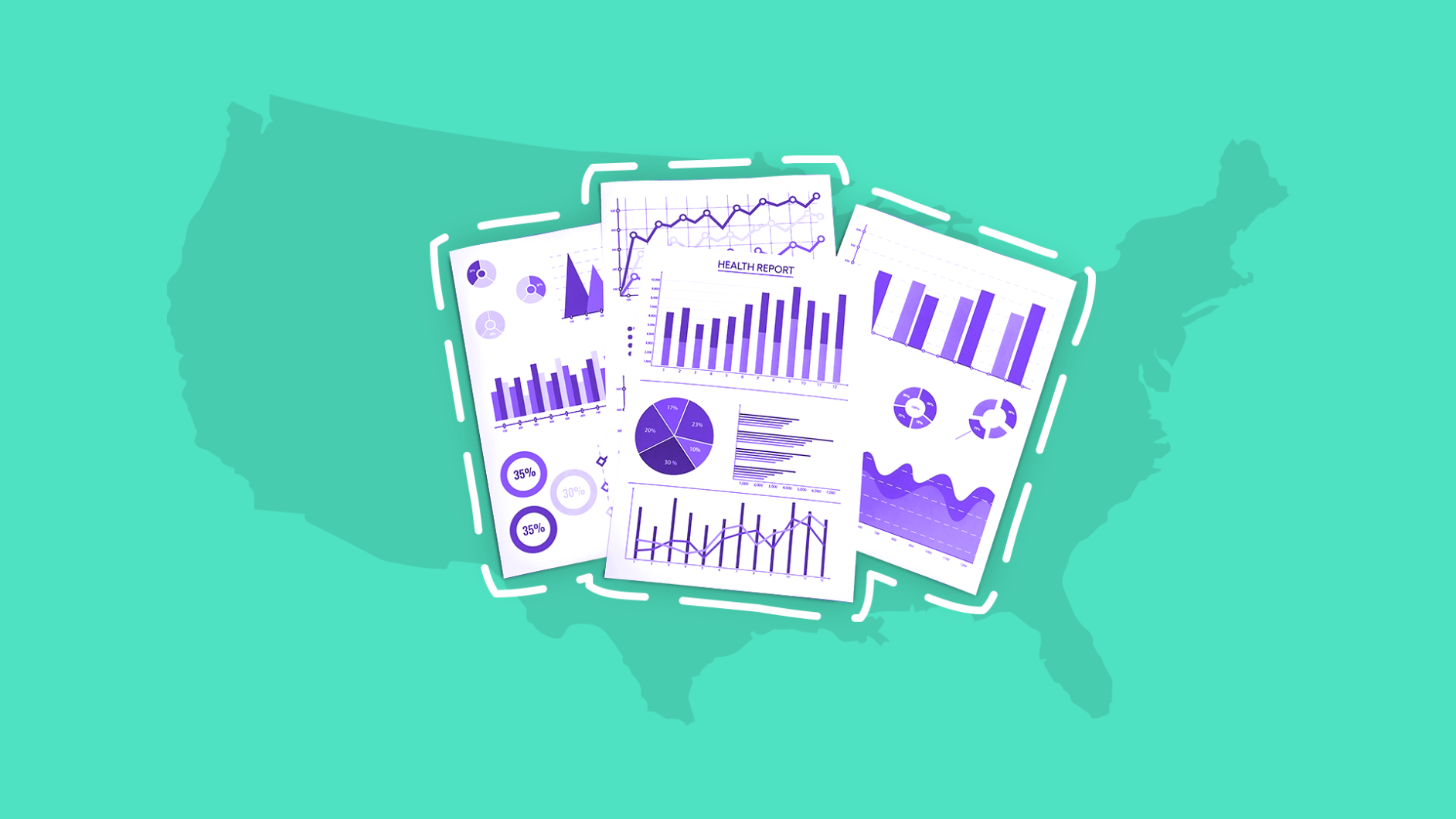Anxiety is an understandable side effect of today’s current events. Between the coronavirus pandemic, social justice issues, and an upcoming presidential election, it’s not farfetched to hypothesize that anxiety could be increasing. SingleCare surveyed 2,000 people to learn more about anxiety in America today. These findings show that the rate of anxiety is increasing in America compared to previous anxiety statistics, particularly the frequently cited National Comorbidity Survey Replication (NCS-R) of 2001-2003.
Summary of our findings:
- 62% experience some degree of anxiety.
- Nearly half of respondents regularly experience anxiety.
- Generalized anxiety disorder is the most common type of anxiety disorder.
- Anxiety is more common in females than in males.
- The average age of diagnosis is between 24 and 35 years old.
- The rate of anxiety diagnosis is low for minority groups.
- Stress at home is the primary cause of anxiety.
- Sleep, relationships, and physical health are most affected by anxiety.
- 75% of respondents with anxiety also have a co-occurring health condition.
- Older respondents aged 55-64 are the least anxious about the COVID-19 pandemic.
- Financial cost is the biggest barrier to accessing anxiety treatment.
62% experience some degree of anxiety
Our findings show an increase in clinical diagnoses of anxiety compared to the 2001-2003 NCS-R. Our survey revealed 21% of respondents have an anxiety diagnosis in 2020 whereas 19% of U.S. adults included in the NCS-R had any anxiety disorder in 2001-2003. We also found that the majority of respondents in America (62%) experience some degree of anxiety whether they have a diagnosis or not.
- 21% of respondents have been clinically diagnosed with anxiety.
- 21% of respondents do not have an anxiety disorder but still experience anxiety occasionally.
- 20% of respondents believe they have anxiety but have not been clinically diagnosed.
- 38% of respondents reportedly do not experience anxiety.
Nearly half of respondents regularly experience anxiety
Almost half (47%) of survey respondents with some degree of anxiety experience it on a regular basis. The majority of which (75%) have experienced anxiety within the past six months.
Of respondents who reported having some degree of anxiety:
- 47% of respondents who experience anxiety experience it regularly.
- 28% of respondents who experience anxiety have experienced it within the last six months.
- 9% of respondents who experience anxiety have experienced it in the past year.
- 5% of respondents who experience anxiety experienced it one to two years ago.
- 4% of respondents who experience anxiety experienced it three to five years ago.
- 7% of respondents who experience anxiety experienced it more than five years ago.
Generalized anxiety disorder is the most common type of anxiety disorder
According to the NCS-R, specific phobias were the most common anxiety disorder, affecting more than 19 million adults in the U.S. between 2001-2003. Specific phobias are an intense, unreasonable fear of a particular object or situation that causes avoidant behavior. However, our survey found that the most common anxiety disorder is generalized anxiety disorder (GAD), a disorder that the NCS-R attributed to less than 3% of U.S. adults in 2001-2003. GAD is characterized by a consistent, ongoing feeling of anxiety or worry that is often unprovoked.
Of respondents who reported having some degree of anxiety:
- 50% have generalized anxiety disorder.
- 39% have mixed anxiety and depressive disorder.
- 32% have social phobia or social anxiety disorder.
- 29% have a panic disorder.
- 21% have post-traumatic stress disorder (PTSD).
- 15% have obsessive-compulsive disorder (OCD).
- 9% do not have an anxiety disorder diagnosis.
- 3% have other types of anxiety disorders such as specific phobias, separation anxiety, etc.
In the context of all Americans:
- 31% have generalized anxiety disorder.
- 24% have mixed anxiety and depressive disorder.
- 20% have social phobia or social anxiety disorder.
- 18% have a panic disorder.
- 13% have post-traumatic stress disorder (PTSD).
- 9% have obsessive-compulsive disorder (OCD).
Anxiety is more common in females than males
Our survey was aligned with past studies that have found that anxiety disorders occur more frequently in females than males. In line with our survey findings that anxiety diagnoses are increasing, our survey also found a 4% higher rate of anxiety in female respondents and a 1% higher rate in male respondents than the NCS-R. The NCS-R found that 23% of female adults and 14% of male adults had an anxiety disorder in 2001-2003. Whereas, our survey found that 27% of female respondents and 15% of male respondents have been diagnosed with an anxiety disorder in 2020. We also found that 52% of females and 39% of males reportedly experience some degree of anxiety on a regular basis.
| Reported anxiety in females vs. males | ||
|---|---|---|
| Females | Males | |
| Clinically diagnosed with anxiety | 27% | 15% |
| Experience anxiety on a regular basis | 52% | 39% |
| Have had a panic attack | 78% | 61% |
Additionally, anxiety symptoms among survey respondents presented in females sooner than males. One in 5 females reported anxiety symptoms starting in childhood (5 to 12 years old) whereas males most commonly noticed symptoms in adulthood.
There are also differences in what respondents believe causes their anxiety between males and females. For example, twice as many males than females believed anxiety as a side effect of medication. Financial security and workplace stress were also more commonly reported causes of anxiety among men than females. On the other hand, trauma and genetics were more commonly reported causes of anxiety among females than males.
| Reported causes of anxiety in females vs. males | ||
|---|---|---|
| Females | Males | |
| Trauma | 30% | 17% |
| Genetics/family history | 26% | 18% |
| Side effect of medication | 3% | 6% |
| Workplace stress | 28% | 34% |
Anxiety can also affect males and females differently. For instance, more females than males with anxiety reported more depressive symptoms and headaches/migraines than males. Meanwhile, males with anxiety reported more problems sleeping than females.
| Comorbidities of anxiety in females vs. males | ||
|---|---|---|
| Females | Males | |
| Depression | 53% | 43% |
| Headaches/migraines | 30% | 19% |
| Sleep disorder | 23% | 31% |
Males and females also cope with anxiety differently. More females than males reported drinking less alcohol, eating, exercising, and socializing less while experiencing anxiety.
| Reported coping mechanisms of anxiety in females vs. males | ||
|---|---|---|
| Behaviors while experiencing anxiety | Females | Males |
| Drink more alcohol | 16% | 21% |
| Eat less | 23% | 18% |
| Exercise less | 40% | 30% |
| Socialize less | 59% | 51% |
RELATED: How to recognize anxiety in men
The average age of diagnosis is between 24 and 35 years old
A poll by the American Psychiatric Association in 2017 found that millennials (24- to 39-year-olds today) are the most anxious generation. Our survey aligned with this pattern as significantly higher levels of anxiety were found among 18- to 35-year-olds as compared to older participants. A third of respondents reported that their anxiety symptoms started between ages 13 and 19. Respondents aged 18- to 24-year-old were more likely to experience symptoms of anxiety but not have a diagnosed disorder while diagnoses were most common among 25- to 34-year-olds. Most middle-aged adult respondents and respondents over 65 years old reported little to no anxiety at all, according to our survey results.
Based on our survey:
- One-third of respondents (33%) reported that their anxiety symptoms started between ages 13 and 19.
- One-third of 18- to 24-year-olds (34%) believe they have anxiety but have not been diagnosed.
- Of the respondents with a clinical diagnosis of anxiety, 28% are 25 to 34 years old. Nearly 60% of respondents in this age group experience anxiety regularly.
- Forty-five percent of adult respondents aged 55 to 64 years old and 53% of senior respondents aged 65+ did not report having anxiety.
- Only 5% of respondents reported that their anxiety symptoms started at age 65, and only 13% of seniors reported a diagnosis of anxiety.
Note: Only adults (18+ years old) were included in our anxiety survey.
The rate of anxiety diagnosis is low for minority groups
White Americans are the most likely to meet the criteria for generalized anxiety disorder, social anxiety disorder, and panic disorder, according to a 2010 study published in The Journal of Nervous and Mental Disease. In the study, African Americans more frequently met the criteria for post-traumatic stress disorder. Asian Americans had consistently lower rates of anxiety disorders than other races.
The following results from our survey align with this pattern:
- A quarter (25%) of white Americans have been clinically diagnosed with anxiety. An additional 18% believe they have anxiety but have not been diagnosed.
- Approximately a quarter of each minority group—Black Americans (24%), Asian-Americans (27%), and Hispanic Americans (23%)—believe they have anxiety but have not been diagnosed.
- However, the rate of diagnosis is low for minority groups. Only 13% of Black Americans and 6% of Asian-Americans have received a diagnosis.
Stress at home is the primary cause of anxiety in America
A combination of genetic and environmental risk factors causes anxiety. Genetic factors could include a family history of anxiety, traits of a shy personality shown at an early age, or physical illness. Environmental factors could include exposure to a traumatic event.
- 48% of respondents reported stress at home causes anxiety.
- 32% reported low self-esteem causes them anxiety. Low self-esteem was most prevalent (46%) among 18- to 24-year-old respondents.
- 30% report workplace stress causes anxiety. Almost half (46%) of respondents who believe workplace stress causes their anxiety were employed full-time. Workplace stress also increases as salary increases. For example, 57% of respondents who experience workplace anxiety make $200,000-$500,000 per year compared to the 22% who earn less than $25,000.
- 30% reportedly believe a co-occurring mental illness causes their anxiety. Depression is the most common co-occurring mental disorder among respondents who reported experiencing anxiety.
- 28% report financial security causes anxiety.
- 26% report the COVID-19 pandemic causes anxiety.
- 25% report trauma causes anxiety.
- 23% reported a family history of anxiety.
- 14% report an underlying health condition causes anxiety.
- 12% report social justice issues cause anxiety. 20% of respondents who believe social justice issues cause their anxiety were students.
- 9% report other causes of anxiety, such as chemical imbalances, health concerns, and relationships.
- 4% report anxiety is a side effect of medication.
- 4% report substance use causes anxiety.
Sleep, relationships, and physical health are most affected by anxiety
Anxiety can interfere with the cadence of everyday life in different ways depending on the type of disorder. “For example, people with panic disorder may stop exercising or having sex to avoid increases in negative physiological symptoms; people with agoraphobia may avoid malls, crowds, driving, or flying—any situation where they might have panic symptoms and not be able to escape or get help,” says Jill Stoddard, Ph.D., a psychologist based in San Diego.
- 61% report that their anxiety affects their ability to sleep; 47% report they sleep less when they experience anxiety.
- 52% report that their anxiety affects their relationships; 56% report they socialize less when they experience anxiety.
- 40% report that their anxiety affects their physical health; 36% report they exercise less when they experience anxiety.
- 39% report that their anxiety affects their school or workplace performance; 67% of students report that anxiety affects their school performance.
- 32% report that their anxiety affects appetite changes; 33% report they eat more when they experience anxiety.
- 29% report that their anxiety affects their overall quality of life.
- 12% report that their anxiety affects substance use/abuse; however, most respondents use illicit drugs less (53%), drink less alcohol (38.2%), and smoke less (46%) when they experience anxiety.
- 9% report that anxiety does not impact their daily life.
- 3% of respondents report other effects of anxiety, including driving, public occasions, and receiving medical treatment.
75% of respondents with anxiety have a co-occurring health condition
Those who experience anxiety often have a co-occurring mental or physical illness (called comorbidity), which may make symptoms of anxiety harder to overcome. Depression is the most common mental health condition to co-occur with anxiety. The highest co-occurrence rate of depression and anxiety is among females (53%) and 25- to 34-year-olds (55%). Below are all co-occurring conditions that participants in our survey have along with anxiety.
- 49% reported depression
- 26% reported a sleep disorder
- 25% reported headaches/migraine
- 20% reported chronic pain
- 11% reported a serious, chronic, or terminal illness (diabetes, arthritis, cancer, etc.)
- 10% reported irritable bowel syndrome (IBS)
- 9% reported an eating disorder
- 8% reported health anxiety (hypochondria)
- 7% reported attention-deficit hyperactivity disorder (ADHD)
- 5% reported fibromyalgia
- 5% reported substance abuse disorder
- 4% reported other health conditions, like autoimmune diseases, bipolar disorder, and multiple sclerosis
- 3% reported hoarding disorder
- 2% reported schizophrenia
- 25% did not report a co-occurring health condition with anxiety
Older respondents aged 55-64 are the least anxious about the COVID-19 pandemic
The COVID-19 pandemic has led to increased levels of stress and anxiety. Our coronavirus survey in March 2020 revealed that almost half (40%) of respondents were concerned that new social distancing guidelines would affect their mental health. At the beginning of lockdowns, 27% of respondents already felt isolated, 15% felt more anxious, and 14% felt more depressed.
Since March, these numbers have increased. In our anxiety survey conducted in August 2020, we found the following statistics:
- 43% have worried more about their health.
- 35% report that quarantine has increased their anxiety.
- 23% report that social distancing has increased their anxiety.
However, not everyone reports feeling anxious about the coronavirus pandemic:
- Quarantine has reportedly decreased anxiety in nearly a tenth (9%) of respondents aged 35 to 44.
- Although seniors aged 65 are considered high risk for coronavirus complications, 31% reported the pandemic has not affected their anxiety and 15% report that their health concerns have not changed.
- An additional 28% of respondents aged 55 to 64 also reported that the pandemic has not affected their anxiety. Nearly a quarter (21%) of them reported using generally healthy coping mechanisms for anxiety.
- More males (27%) than females (20%) reported the pandemic has not affected their anxiety.
Financial cost is the biggest barrier to accessing anxiety treatment
“Anxiety disorders are highly treatable, yet only 36.9% of those suffering receive treatment,” says Sanam Hafeez, Psy.D., a neuropsychologist in New York City and faculty member at Columbia University. However, our survey found that more people are seeking treatment for their anxiety, as 47% of respondents with anxiety reported use of medication or therapy for anxiety. We took a look at the possible barriers preventing people from seeking treatment and found that among survey participants the cost of medication or therapy was the biggest burden.
- 27% report the financial cost of therapy and/or medication is the biggest barrier to anxiety treatment.
- 26% report they do not need anxiety treatment.
- 24% report they do not have any barriers to treatment.
- 17% report they don’t know what their resources or options are. A quarter of those who believe they have anxiety but have not been clinically diagnosed do not know what their resources or options are.
- 13% say social stigmas surrounding mental health disorders keep them from getting help. Social stigmas keep 22% of 18- to 24-year-olds from getting help.
- 12% report the location of the treatment center is inconvenient.
- 10% report their insurance doesn’t cover anxiety treatment.
- 5% report other barriers, such as the COVID-19 pandemic. For example, 11% of young people aged 18 to 24 have seen their therapist or mental health professional less during the pandemic and 6% have stopped taking their anxiety medication altogether.
Additionally, for those who do receive treatment for anxiety, only 12% report their treatment is very effective, meaning it alleviates anxiety completely or almost completely. Twenty-eight percent report their treatment is mildly effective and 7% report their treatment is not effective. The majority (53%) do not use medication or therapy at all.
Our methodology:
SingleCare conducted this anxiety survey online through AYTM on August 4, 2020. This survey includes 2,000 United States residents adults ages 18+. Age and gender were census-balanced to match the U.S. population in age, gender, and U.S. region.











